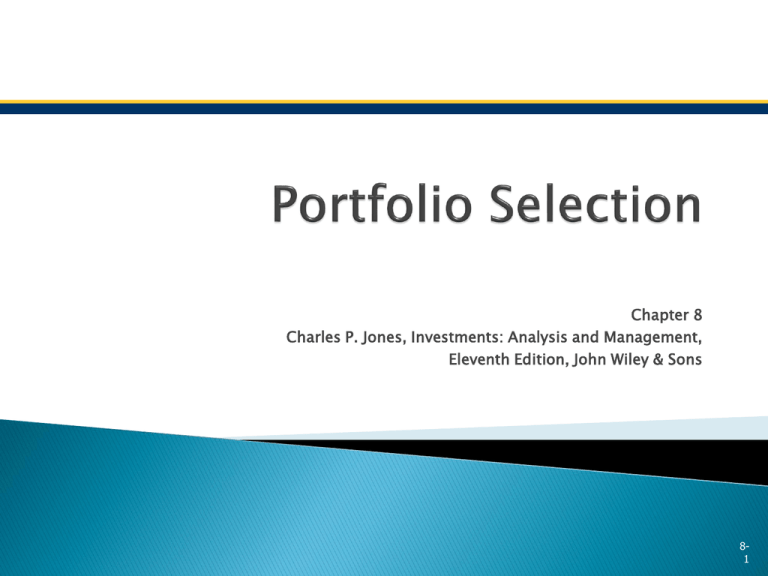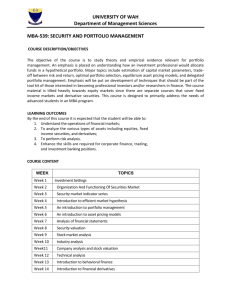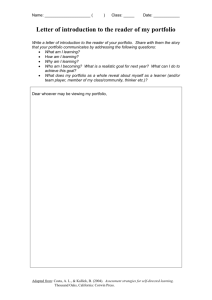
Chapter 8
Charles P. Jones, Investments: Analysis and Management,
Eleventh Edition, John Wiley & Sons
81
Diversification is key to optimal risk
management
Analysis required because of the infinite
number of portfolios of risky assets
How should investors select the best risky
portfolio?
How could riskless assets be used?
82
Step 1: Use the Markowitz portfolio selection
model to identify optimal combinations
◦ Estimate expected returns, risk, and each
covariance between returns
Step 2: Choose the final portfolio based on
your preferences for return relative to risk
83
Optimal diversification takes into account all
available information
Assumptions in portfolio theory
◦ A single investment period (one year)
◦ Liquid position (no transaction costs)
◦ Preferences based only on a portfolio’s expected
return and risk
84
Smallest portfolio risk for a given level of
expected return
Largest expected return for a given level of
portfolio risk
From the set of all possible portfolios
◦ Only locate and analyze the subset known as the
efficient set
Lowest risk for given level of return
85
x
B
E(R) A
y
C
Risk =
Efficient frontier or
Efficient set
(curved line from A
to B)
Global minimum
variance portfolio
(represented by
point A)
86
Assume investors are risk averse
Indifference curves help select from efficient
set
◦ Description of preferences for risk and return
◦ Portfolio combinations which are equally desirable
◦ Greater slope implies greater the risk aversion
87
Markowitz portfolio selection model
◦ Generates a frontier of efficient portfolios which are
equally good
◦ Does not address the issue of riskless borrowing or
lending
◦ Different investors will estimate the efficient
frontier differently
Element of uncertainty in application
88
1)
2)
3)
4)
5)
Mark used the techniques of quadratic
programming to identify the efficient portfolio
Using the expected return and risk of each security
under consideration and the covariance estimates
for each pair of securities, he calculated risk and
return for all possible portfolios
Then for any specific value of expected portfolio
return, he determined the least risk portfolio using
quadratic prog.
With another value of expected portfolio return, a
similar procedure again give the minimum risk
portfolio.
The process is repeated with different values of
expected return, the resulting minimum risk
portfolios constitute the set of efficient portfolios.
Large number of input is required.
The computation is complex and
complicated.
Little practical application.
Simplification is needed. And it is achieved by
the index model.
Relates returns on each security to the
returns on a common index, such as the S&P
500 Stock Index, KSE 100 Index etc.
Expressed by the following equation
Ri α i βi RM ei
Divides return into two components
◦ a unique part, ai
◦ a market-related part, biRM
811
◦ b measures the sensitivity of a stock to stock
market movements
◦ If securities are only related in their common
response to the market
Securities covary together only because of their
common relationship to the market index
Security covariances depend only on market risk and
can be written as:
σ ij
2
βi β j σ M
812
Single index model helps split a security’s
total risk into
◦ Total risk = market risk + unique risk
2
σ i2 βi2 [σ M ] σ ei
Multi-Index models as an alternative
◦ Between the full variance-covariance method of
Markowitz and the single-index model
813
Another way to use Markowitz model is with
asset classes
◦ Allocation of portfolio assets to broad asset
categories
Asset class rather than individual security decisions
most important for investors
◦ Different asset classes offers various returns and
levels of risk
Correlation coefficients may be quite low
814
Decision about the proportion of portfolio
assets allocated to equity, fixed-income, and
money market securities
◦ Widely used application of Modern Portfolio Theory
◦ Because securities within asset classes tend to
move together, asset allocation is an important
investment decision
◦ Should consider international securities, real estate,
and U.S. Treasury TIPS
815
Investors should focus on risk that cannot be
managed by diversification
Total risk =systematic (nondiversifiable) risk
+ nonsystematic (diversifiable) risk
◦ Systematic risk
Variability in a security’s total returns directly
associated with economy-wide events
Common to virtually all securities
◦ Both risk components can vary over time
Affects number of securities needed to diversify
816
p %
Portfolio risk
35
20
Market Risk
0
10
20
30
40
......
Number of securities in portfolio
100+
Copyright 2010 John Wiley & Sons, Inc. All rights reserved.
Reproduction or translation of this work beyond that
permitted in Section 117 of the 1976 United states
Copyright Act without the express written permission of
the copyright owner is unlawful. Request for further
information should be addressed to the Permissions
department, John Wiley & Sons, Inc. The purchaser may
make back-up copies for his/her own use only and not for
distribution or resale. The Publisher assumes no
responsibility for errors, omissions, or damages, caused
by the use of these programs or from the use of the
information contained herein.
818






